We're in the middle of our crowdfunding campaign, and since some individuals have expressed their interest in the structure we are constructing, I thought I should tell a bit more about our amazing Rehearsal Room we are raising funds for. Admittedly, Itínera's project is much greater than this one building. It's about artists, and workshops, and performances, and education, and the community, all true enough. But this first building of what is eventually going to be a greater theater complex is certainly worth paying close attention to. After all, it's what catches the eyes of whoever happens to pass by our property. And a closer look reveals the sustainable techniques it was built with, the self-sustaining nature of its systems, and the autonomous way it will take care of its own needs. But let's take it step by step:
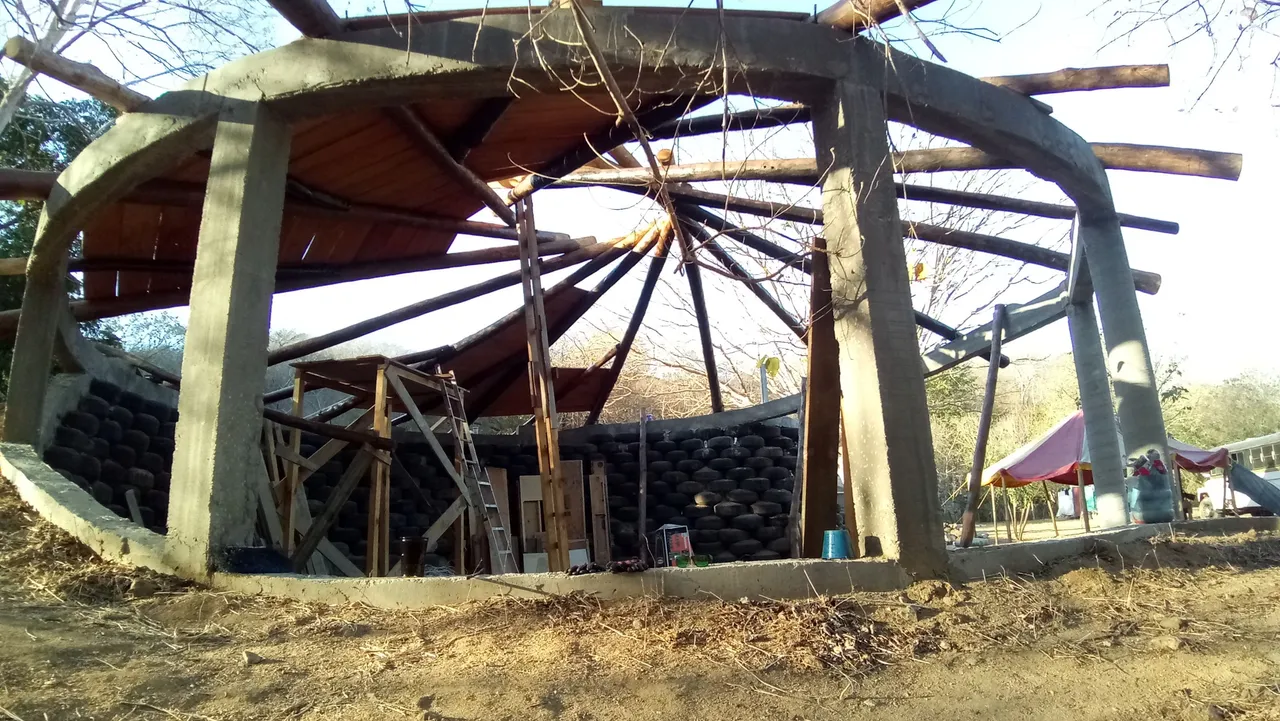
A Wall Built Out of Tires
Okay, this point may be not the most important one, but it's what people tend to notice first, so I'll get it out of the way. A used car tire offers itself perfectly to be filled with dirt, and compact it to the max. Even a small tire can eat up around 100 liters (25 gallons) of soil, turning it into a very heavy brick-like unit. Placed on top of each other, they will form a super heavy, and thus stable wall, which however will retain a bit of its flexibility. It's made out of rubber, after all. This comes in super handy when it has to resist earthquakes. Sure, the plaster may crack and crumble, but the wall itself is going to absorb the movement of the ground. Also, it will withstand flooding, be unaffected by fires, and form a protective layer against radiation (should that ever be the case). Most importantly, though, it turns a serious problem into a useful building material. I mean, what else could you do with old tires, other than burning them (quickly contaminating our atmosphere), or tossing them (contaminating our soil and water)? In our structure we managed to incorporate about 500 tires, which means 500 less tires wrecking our ecosystem. And once they are plastered over, there is no chance of off-gassing.
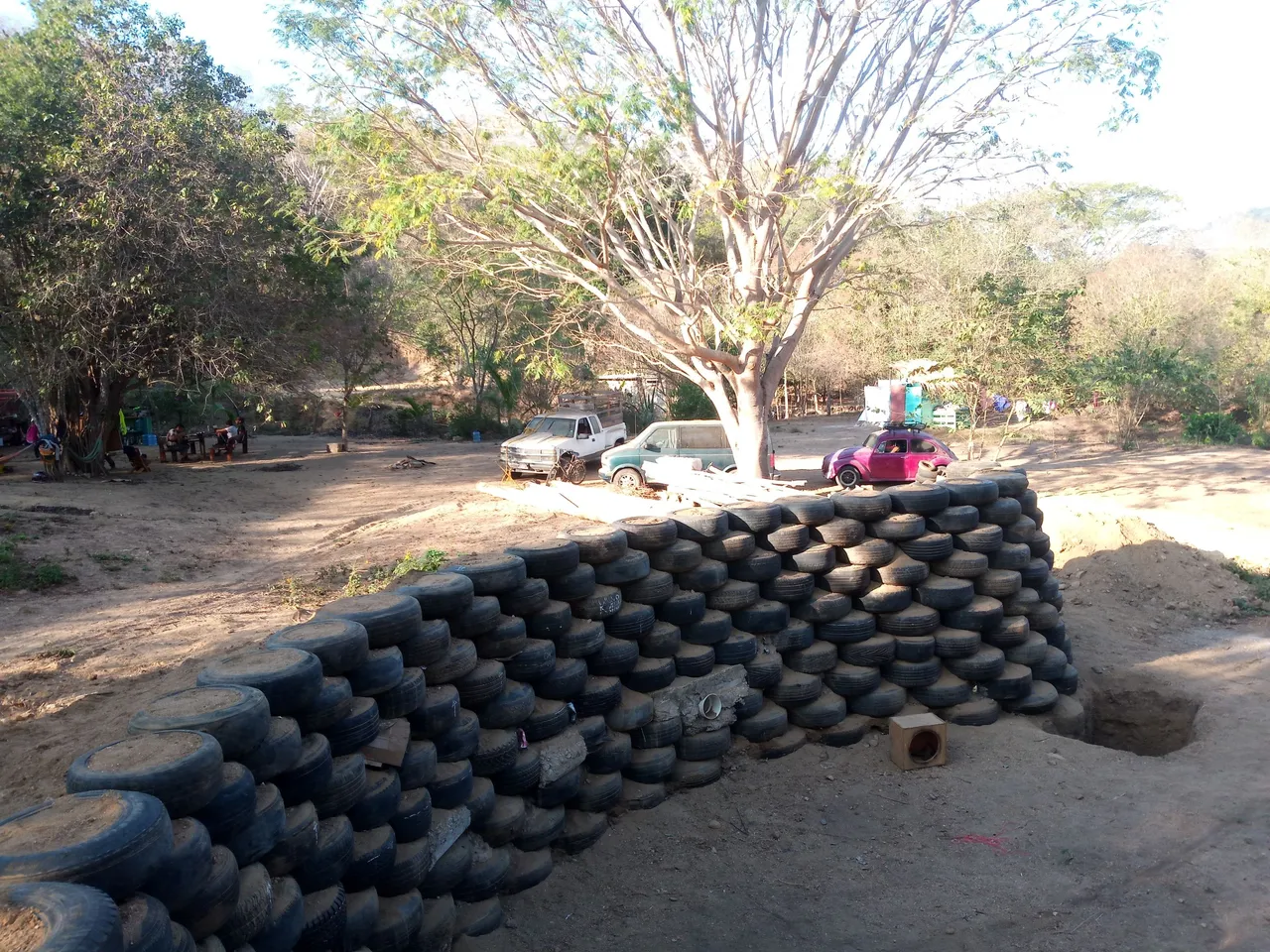
Passively Cooled Through Convection
This one's a biggie, so I want to address it next. Due to its geographic location, the weather in Mazunte is always hot and humid, even in the so called dry season. As a result people are always looking for shade, fans, and air-conditioned spaces. Instead of investing money and energy into these electric / mechanic solutions, which drain your pockets and are bound to break down, we decided to apply a classic Earthship technology (which can also be seen in many ancient African and Mid-Eastern architecture): Convection Cooling. The principle is simple: hot air rises inside our building, and we let it escape through the hole in the center of the roof. Abhorring a vacuum, as the air escapes, it draws more air inside through the three cooling tubes that run through the mound of dirt bermed up behind the wall. Since this subterranean air is cooler than what's inside the room, it is going to feel like a refreshing breeze flowing through the building whenever it's hot outside. And all this without relying on any energy intensive systems.
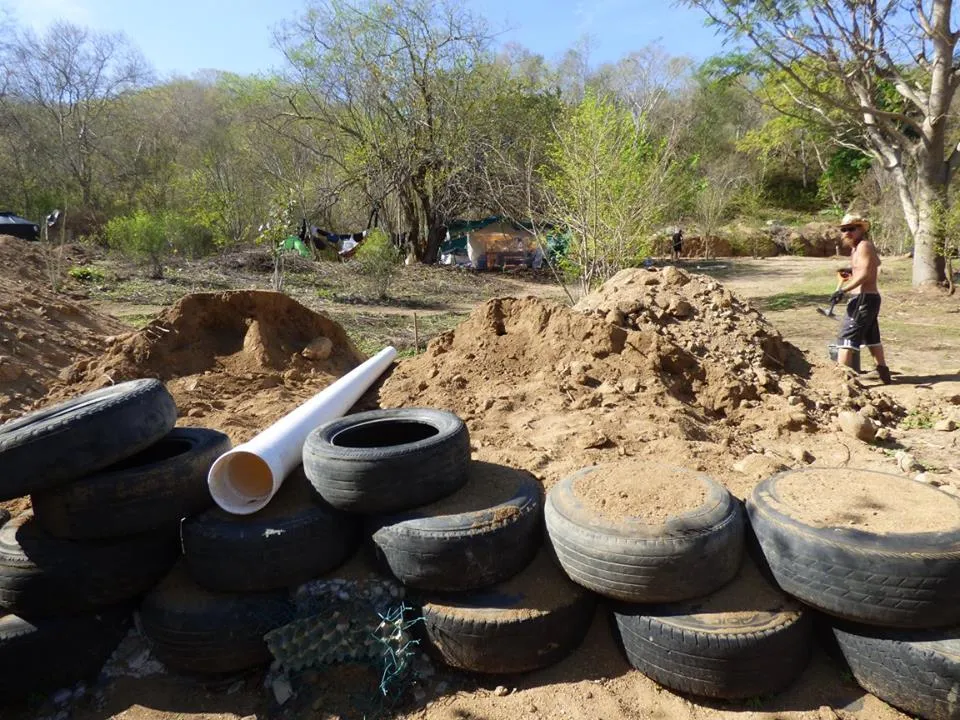
The Benefits of a Green Roof
Looking at our structure from its Southern side, one may not even recognize it as a building. It would probably look more like a giant hill of some type. That's because the berm behind its tire wall, and the green roof above it, are indeed a hill, that is a gently sloping pile of soil, covered in vegetation. With its wild plants it does look pretty, especially when the flowers are in bloom. But in spite of its beauty, the esthetics of a green roof are only part of the reason we decided to use one, though it deserves to be mentioned too. Another important reason is once again cooling. On top of the wooden boards covering the roof beams we placed a geo-membrane, followed by a layer of gravel, and a layer of soil of about 20 cm depth. This alone should be enough to cool the space below it significantly, but then there is a thick layer of plants growing in this soil, not to mention the water soaked up by both plants and soil. Together they will most likely bring down the temperature even further. But there is yet another benefit, having to do with water: Rainwater tends to be quite clean anyway, especially in a place like Mazunte. But since we want to harvest our rain, it helps if we let it pass through the layers on the roof, to really clean it of any impurities.

Meeting Water and Energy Needs
By calling the building autonomous, we mean that it will not be connected to the municipal grids of water or electricity (let alone sewer). In other words, we are planing on taking care of these things on our own... or let's say, we'll let the building meet its own needs. So far we have been getting our water for showering, washing dishes, but also watering our plants, from the "pipa", that is tank trucks pumping up water from the local wells, and delivering into large tanks people have on their roofs or back yards. Once we have installed the cistern in the berm, all the rainwater from our roof is going to drain into it, providing (hopefully) most of our water needs. As for electric power, the solution is simple: setting up a small photovoltaic system on the roof, which we will extend according to need. While the cistern is most probably a project for a bit later, a solar system is very likely to be set up this coming season. By the way, if you were wondering about the sewer, we intend to bypass it all together, by relying on composting toilets.
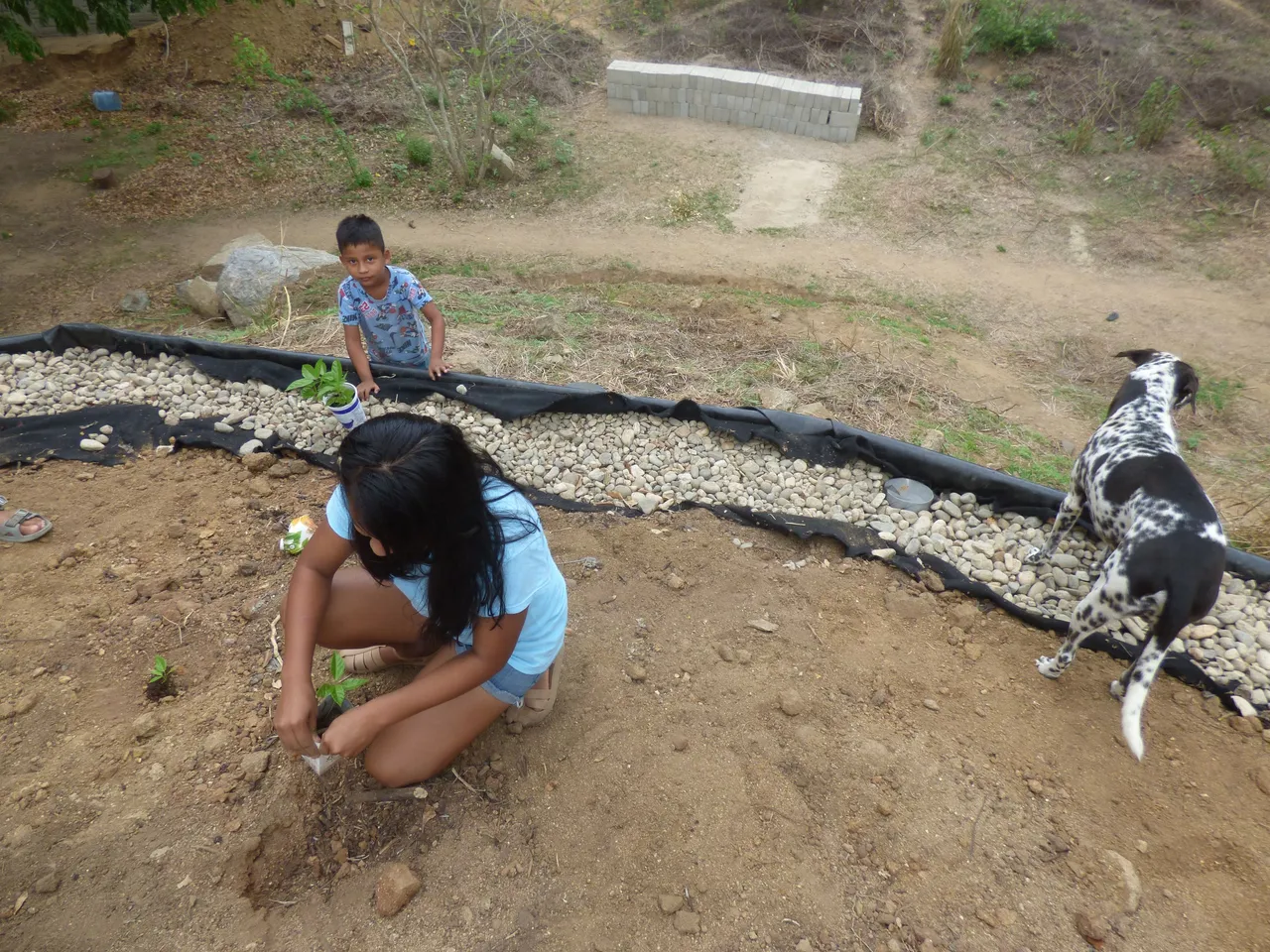
A Huge Rehearsal Space With No Columns
One of the most awesome aspects of our Rehearsal Room is the massive round floor space of ten meters in diameter. This will be great for all kinds of purposes, from meetings and conferences, to dance workshops, interactive performances that blur the lines between performers and audience, not to mention storage space for when we are not there. But have you ever wondered how we created such a large area without any columns to block the way? The answer is our ingenious reciprocal roof. Take a close look at the roof beams: Each one is resting on its left neighbor, while carrying its right one. This way the weight of the entire roof (including all the wood, gravel, dirt, plants, and most importantly water) is evenly distributed. What a cool architectural trick! We are certain to make more use of it in future buildings as well, maybe even in our main theater building. Of course, this large floor area is useless without a finished floor, which is one of the key implements we would like to cover with this campaign.
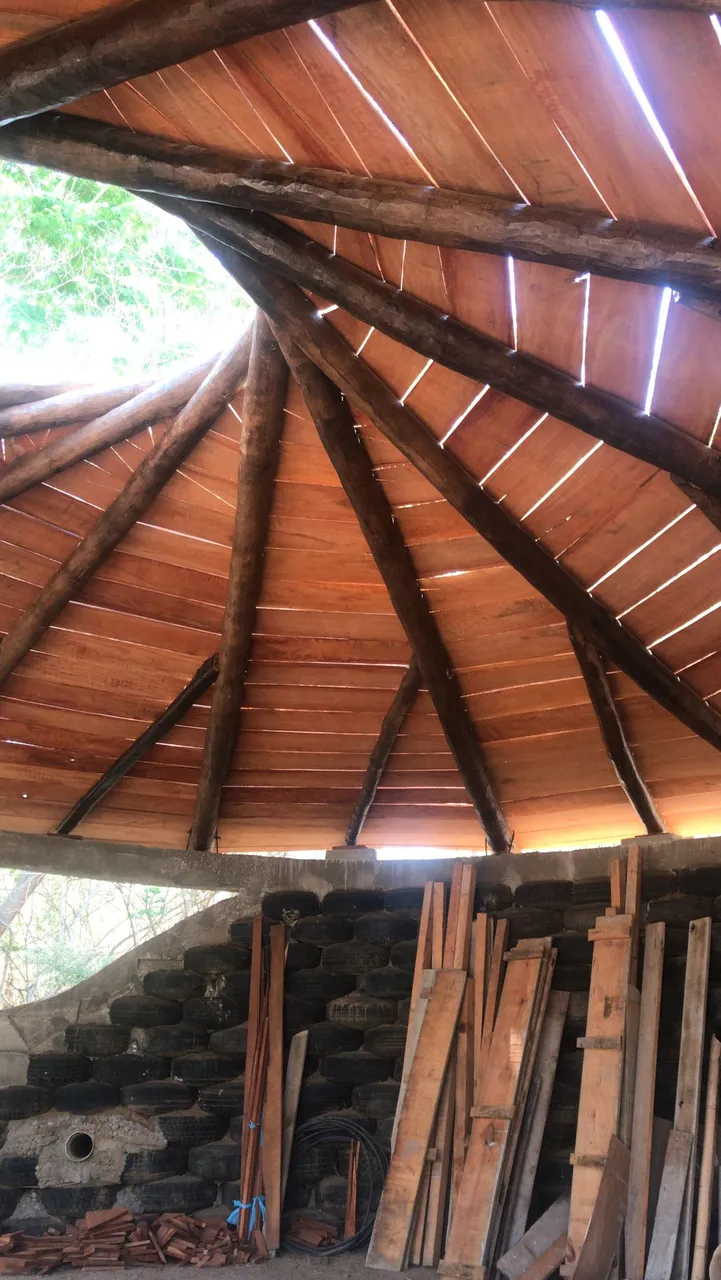
Help Us Complete This Awesome Building!
So yeah, this is our little treasure box of a theater building. It's actually almost done, so to speak, it only needs a finished floor, and some windows and a door. Also, the walls need to be plastered, plus a solar power system installed. The water cistern is probably a later project, unless of course we manage to go way beyond our crowdfunding goal of €16,000. So if you want to help, why don't you take a look at our crowdfunding page, watch our funny campaign video, and even if you don't have any money to send our way (something we always appreciate greatly), what you can do is share our campaign with all the people you know! That may actually be the best way to support us, and we are eternally grateful to you. For a very quick access, here the QR code leading to our campaign:

Finally, if you are really interested in the building process of this Rehearsal Room, take a look at all these posts I've written about it:
2020:
Creating Conditions to Work and Live
The Challenge of Scoring Tires
Working at Night for the Perfect Level
Bending Rebar Like a Mexican
An Impression of Hyper-adobe in La Boquilla
Waiting for the Man
The Diverse Cars at Itínera
Hay Pase, Got the Permit!
The Ceremony of a Minka
Zome Building Workshop in Mazunte
Machines Taking Over Work: The Day Everything Changed
Earthship Build in the Time of Hive and Coronavirus
Concrete Plans and Concrete Actions
Starting The Long Finish
The Circle is Complete, We're Pouring Tomorrow
Pouring the Bond Beam
Visual Concrete Pour by @redhawkrising
Talking About Logs
Moving Logs Around in Practice
Mission Accomplished!
A View From a Bird’s Eye
Epilogue
2021:
Lost and Found: The Promotional Video for the Theater on the Beach
Back in the Circus of Mazunte
Up on the Roof Again
Teaching a Reciprocal Roof Workshop
Green Mazunte
Yoga for Construction Work
The Quickest Tent Structure: Building a Flex Yurt
Vegan Days with Fabiola
Mission Completed ... Without Me
